Manchester United: Stakeholder Analysis and Cultural Evolution Report
VerifiedAdded on 2021/01/02
|11
|3226
|299
Report
AI Summary
This report provides a comprehensive analysis of Manchester United Football Club's business strategy. It begins by identifying the key stakeholders, including the Glazer family, financial institutions, and fans, and evaluates their power and attention using the Stakeholder Mapping model. The report then critically examines the cultural characteristics of Manchester United since becoming a PLC in 1991, highlighting shifts in values, beliefs, and priorities. The analysis explores how the club's focus has evolved from winning on the field to also prioritizing financial gains. The report concludes by discussing the implications of these changes for current and future strategies, emphasizing the impact of financial fair play regulations and the club's broader football revenue. Overall, the report offers a detailed overview of the club's strategic evolution and stakeholder dynamics.

Business Strategy
Paraphrase This Document
Need a fresh take? Get an instant paraphrase of this document with our AI Paraphraser
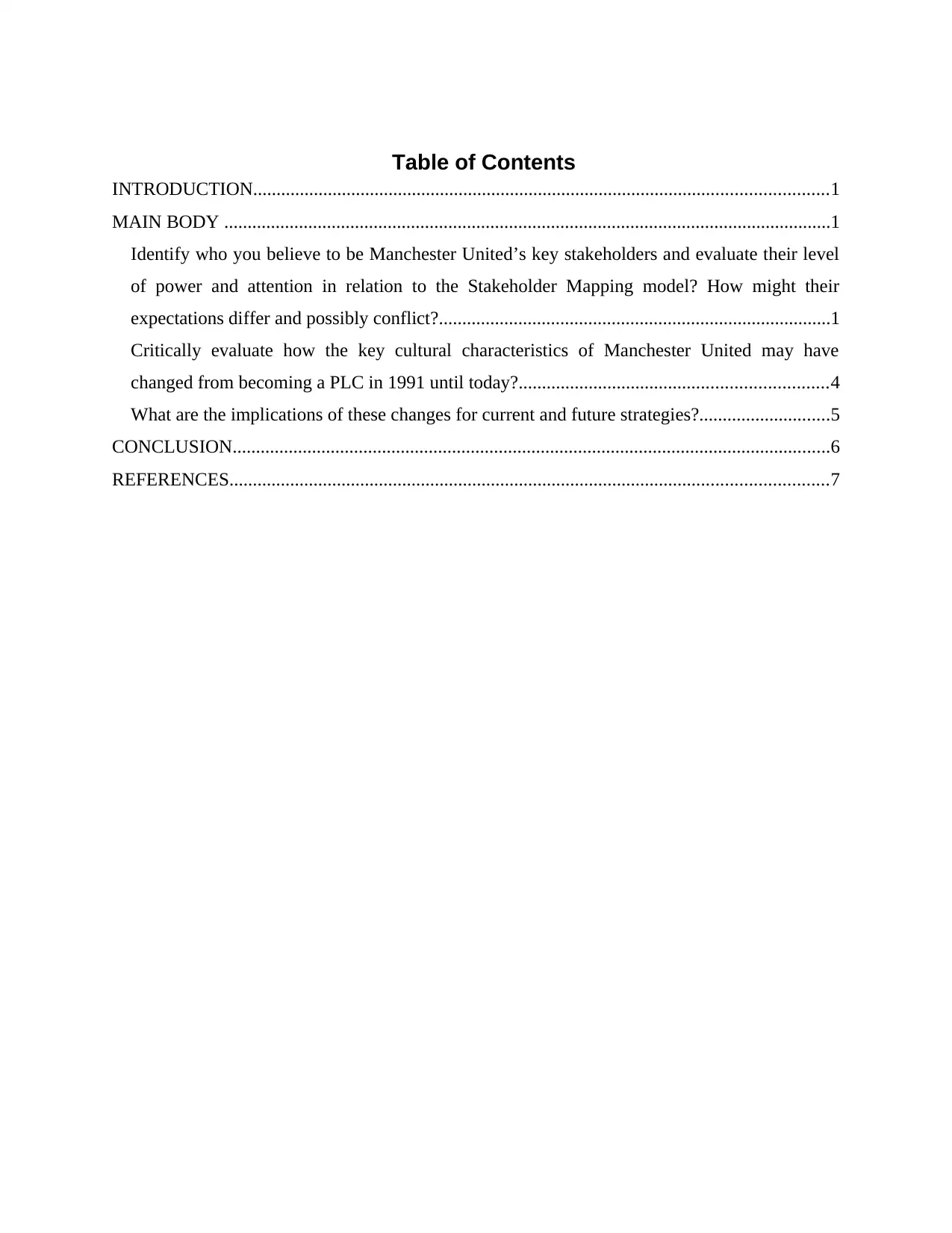
Table of Contents
INTRODUCTION...........................................................................................................................1
MAIN BODY ..................................................................................................................................1
Identify who you believe to be Manchester United’s key stakeholders and evaluate their level
of power and attention in relation to the Stakeholder Mapping model? How might their
expectations differ and possibly conflict?....................................................................................1
Critically evaluate how the key cultural characteristics of Manchester United may have
changed from becoming a PLC in 1991 until today?..................................................................4
What are the implications of these changes for current and future strategies?............................5
CONCLUSION................................................................................................................................6
REFERENCES................................................................................................................................7
INTRODUCTION...........................................................................................................................1
MAIN BODY ..................................................................................................................................1
Identify who you believe to be Manchester United’s key stakeholders and evaluate their level
of power and attention in relation to the Stakeholder Mapping model? How might their
expectations differ and possibly conflict?....................................................................................1
Critically evaluate how the key cultural characteristics of Manchester United may have
changed from becoming a PLC in 1991 until today?..................................................................4
What are the implications of these changes for current and future strategies?............................5
CONCLUSION................................................................................................................................6
REFERENCES................................................................................................................................7

⊘ This is a preview!⊘
Do you want full access?
Subscribe today to unlock all pages.

Trusted by 1+ million students worldwide
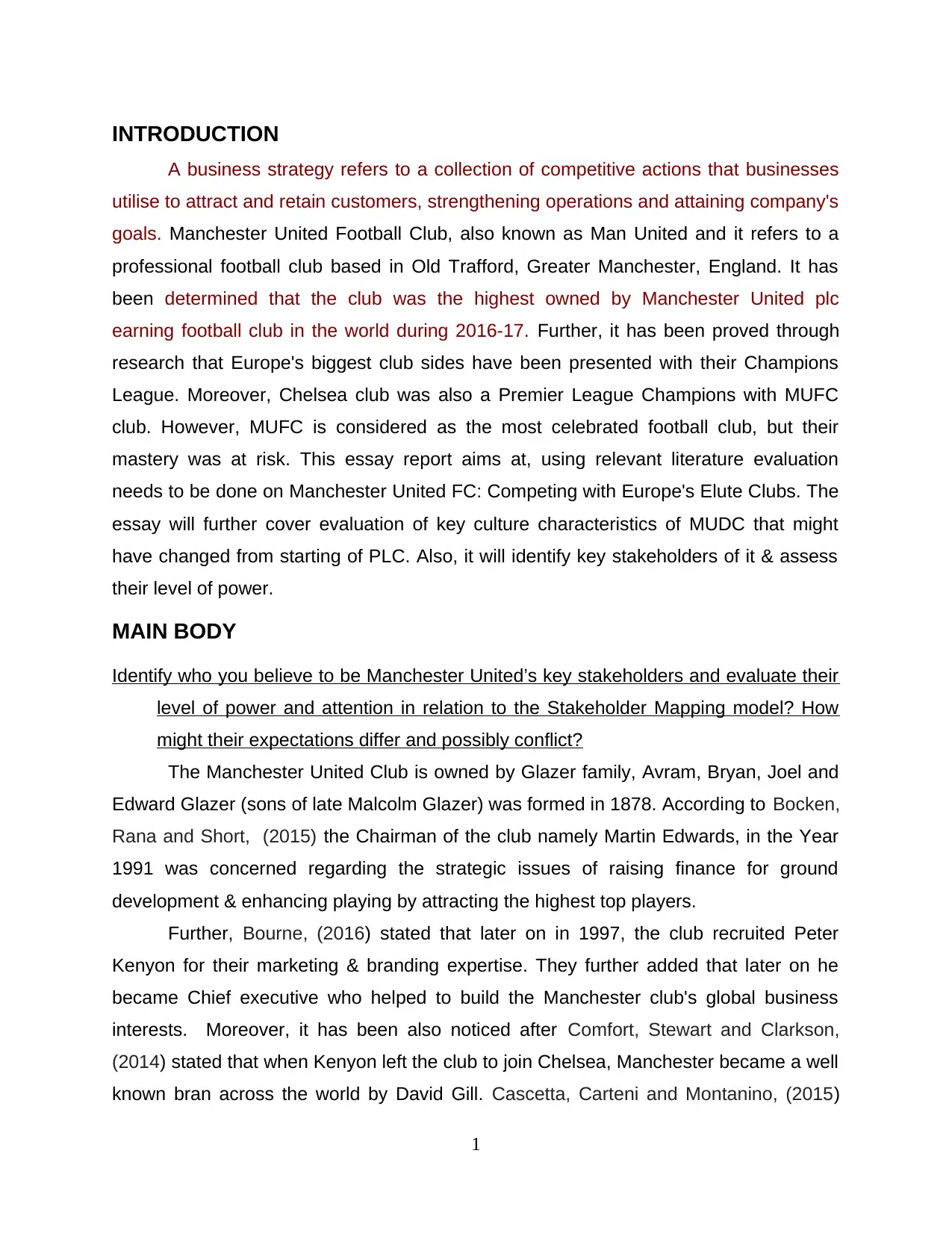
INTRODUCTION
A business strategy refers to a collection of competitive actions that businesses
utilise to attract and retain customers, strengthening operations and attaining company's
goals. Manchester United Football Club, also known as Man United and it refers to a
professional football club based in Old Trafford, Greater Manchester, England. It has
been determined that the club was the highest owned by Manchester United plc
earning football club in the world during 2016-17. Further, it has been proved through
research that Europe's biggest club sides have been presented with their Champions
League. Moreover, Chelsea club was also a Premier League Champions with MUFC
club. However, MUFC is considered as the most celebrated football club, but their
mastery was at risk. This essay report aims at, using relevant literature evaluation
needs to be done on Manchester United FC: Competing with Europe's Elute Clubs. The
essay will further cover evaluation of key culture characteristics of MUDC that might
have changed from starting of PLC. Also, it will identify key stakeholders of it & assess
their level of power.
MAIN BODY
Identify who you believe to be Manchester United’s key stakeholders and evaluate their
level of power and attention in relation to the Stakeholder Mapping model? How
might their expectations differ and possibly conflict?
The Manchester United Club is owned by Glazer family, Avram, Bryan, Joel and
Edward Glazer (sons of late Malcolm Glazer) was formed in 1878. According to Bocken,
Rana and Short, (2015) the Chairman of the club namely Martin Edwards, in the Year
1991 was concerned regarding the strategic issues of raising finance for ground
development & enhancing playing by attracting the highest top players.
Further, Bourne, (2016) stated that later on in 1997, the club recruited Peter
Kenyon for their marketing & branding expertise. They further added that later on he
became Chief executive who helped to build the Manchester club's global business
interests. Moreover, it has been also noticed after Comfort, Stewart and Clarkson,
(2014) stated that when Kenyon left the club to join Chelsea, Manchester became a well
known bran across the world by David Gill. Cascetta, Carteni and Montanino, (2015)
1
A business strategy refers to a collection of competitive actions that businesses
utilise to attract and retain customers, strengthening operations and attaining company's
goals. Manchester United Football Club, also known as Man United and it refers to a
professional football club based in Old Trafford, Greater Manchester, England. It has
been determined that the club was the highest owned by Manchester United plc
earning football club in the world during 2016-17. Further, it has been proved through
research that Europe's biggest club sides have been presented with their Champions
League. Moreover, Chelsea club was also a Premier League Champions with MUFC
club. However, MUFC is considered as the most celebrated football club, but their
mastery was at risk. This essay report aims at, using relevant literature evaluation
needs to be done on Manchester United FC: Competing with Europe's Elute Clubs. The
essay will further cover evaluation of key culture characteristics of MUDC that might
have changed from starting of PLC. Also, it will identify key stakeholders of it & assess
their level of power.
MAIN BODY
Identify who you believe to be Manchester United’s key stakeholders and evaluate their
level of power and attention in relation to the Stakeholder Mapping model? How
might their expectations differ and possibly conflict?
The Manchester United Club is owned by Glazer family, Avram, Bryan, Joel and
Edward Glazer (sons of late Malcolm Glazer) was formed in 1878. According to Bocken,
Rana and Short, (2015) the Chairman of the club namely Martin Edwards, in the Year
1991 was concerned regarding the strategic issues of raising finance for ground
development & enhancing playing by attracting the highest top players.
Further, Bourne, (2016) stated that later on in 1997, the club recruited Peter
Kenyon for their marketing & branding expertise. They further added that later on he
became Chief executive who helped to build the Manchester club's global business
interests. Moreover, it has been also noticed after Comfort, Stewart and Clarkson,
(2014) stated that when Kenyon left the club to join Chelsea, Manchester became a well
known bran across the world by David Gill. Cascetta, Carteni and Montanino, (2015)
1
Paraphrase This Document
Need a fresh take? Get an instant paraphrase of this document with our AI Paraphraser
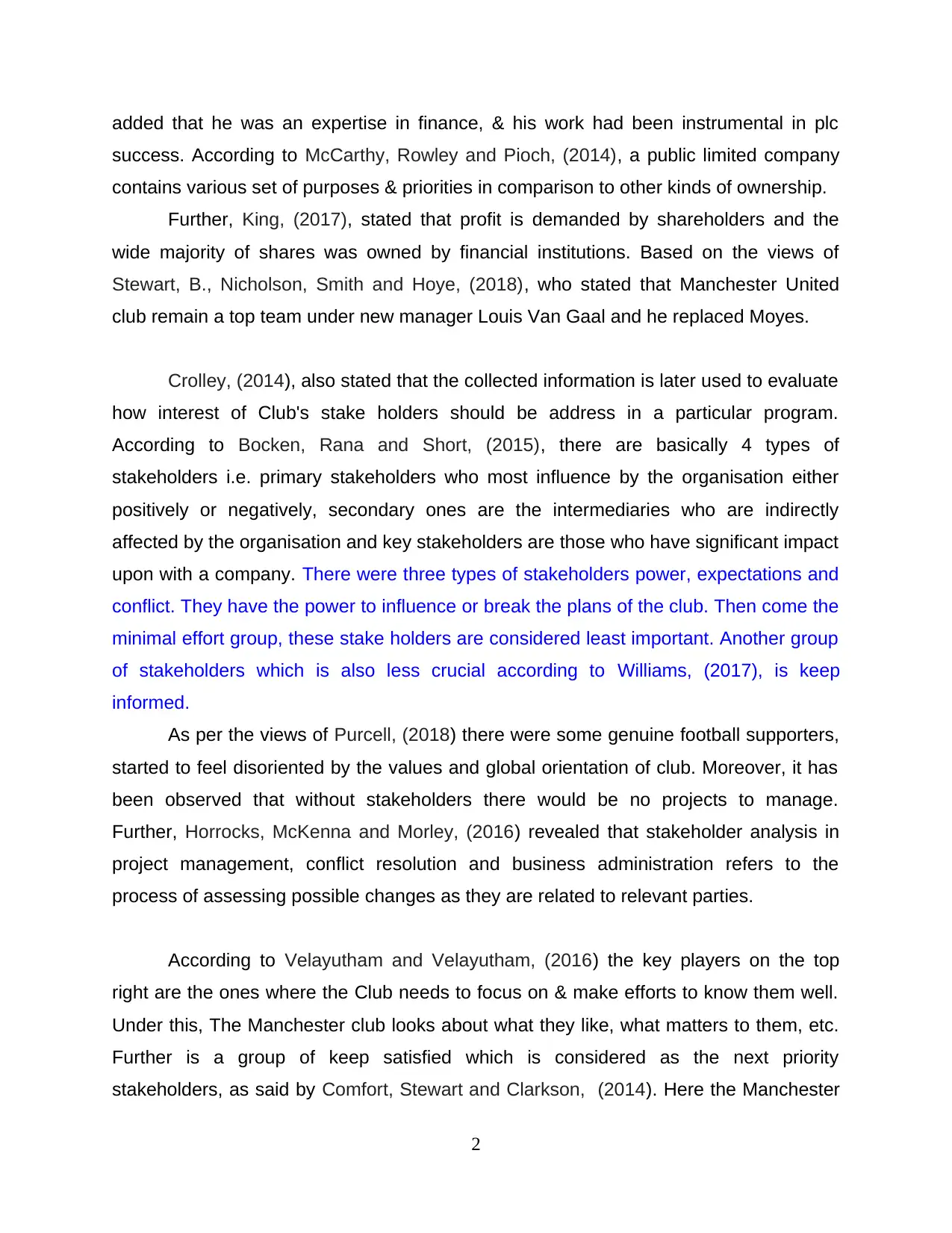
added that he was an expertise in finance, & his work had been instrumental in plc
success. According to McCarthy, Rowley and Pioch, (2014), a public limited company
contains various set of purposes & priorities in comparison to other kinds of ownership.
Further, King, (2017), stated that profit is demanded by shareholders and the
wide majority of shares was owned by financial institutions. Based on the views of
Stewart, B., Nicholson, Smith and Hoye, (2018), who stated that Manchester United
club remain a top team under new manager Louis Van Gaal and he replaced Moyes.
Crolley, (2014), also stated that the collected information is later used to evaluate
how interest of Club's stake holders should be address in a particular program.
According to Bocken, Rana and Short, (2015), there are basically 4 types of
stakeholders i.e. primary stakeholders who most influence by the organisation either
positively or negatively, secondary ones are the intermediaries who are indirectly
affected by the organisation and key stakeholders are those who have significant impact
upon with a company. There were three types of stakeholders power, expectations and
conflict. They have the power to influence or break the plans of the club. Then come the
minimal effort group, these stake holders are considered least important. Another group
of stakeholders which is also less crucial according to Williams, (2017), is keep
informed.
As per the views of Purcell, (2018) there were some genuine football supporters,
started to feel disoriented by the values and global orientation of club. Moreover, it has
been observed that without stakeholders there would be no projects to manage.
Further, Horrocks, McKenna and Morley, (2016) revealed that stakeholder analysis in
project management, conflict resolution and business administration refers to the
process of assessing possible changes as they are related to relevant parties.
According to Velayutham and Velayutham, (2016) the key players on the top
right are the ones where the Club needs to focus on & make efforts to know them well.
Under this, The Manchester club looks about what they like, what matters to them, etc.
Further is a group of keep satisfied which is considered as the next priority
stakeholders, as said by Comfort, Stewart and Clarkson, (2014). Here the Manchester
2
success. According to McCarthy, Rowley and Pioch, (2014), a public limited company
contains various set of purposes & priorities in comparison to other kinds of ownership.
Further, King, (2017), stated that profit is demanded by shareholders and the
wide majority of shares was owned by financial institutions. Based on the views of
Stewart, B., Nicholson, Smith and Hoye, (2018), who stated that Manchester United
club remain a top team under new manager Louis Van Gaal and he replaced Moyes.
Crolley, (2014), also stated that the collected information is later used to evaluate
how interest of Club's stake holders should be address in a particular program.
According to Bocken, Rana and Short, (2015), there are basically 4 types of
stakeholders i.e. primary stakeholders who most influence by the organisation either
positively or negatively, secondary ones are the intermediaries who are indirectly
affected by the organisation and key stakeholders are those who have significant impact
upon with a company. There were three types of stakeholders power, expectations and
conflict. They have the power to influence or break the plans of the club. Then come the
minimal effort group, these stake holders are considered least important. Another group
of stakeholders which is also less crucial according to Williams, (2017), is keep
informed.
As per the views of Purcell, (2018) there were some genuine football supporters,
started to feel disoriented by the values and global orientation of club. Moreover, it has
been observed that without stakeholders there would be no projects to manage.
Further, Horrocks, McKenna and Morley, (2016) revealed that stakeholder analysis in
project management, conflict resolution and business administration refers to the
process of assessing possible changes as they are related to relevant parties.
According to Velayutham and Velayutham, (2016) the key players on the top
right are the ones where the Club needs to focus on & make efforts to know them well.
Under this, The Manchester club looks about what they like, what matters to them, etc.
Further is a group of keep satisfied which is considered as the next priority
stakeholders, as said by Comfort, Stewart and Clarkson, (2014). Here the Manchester
2
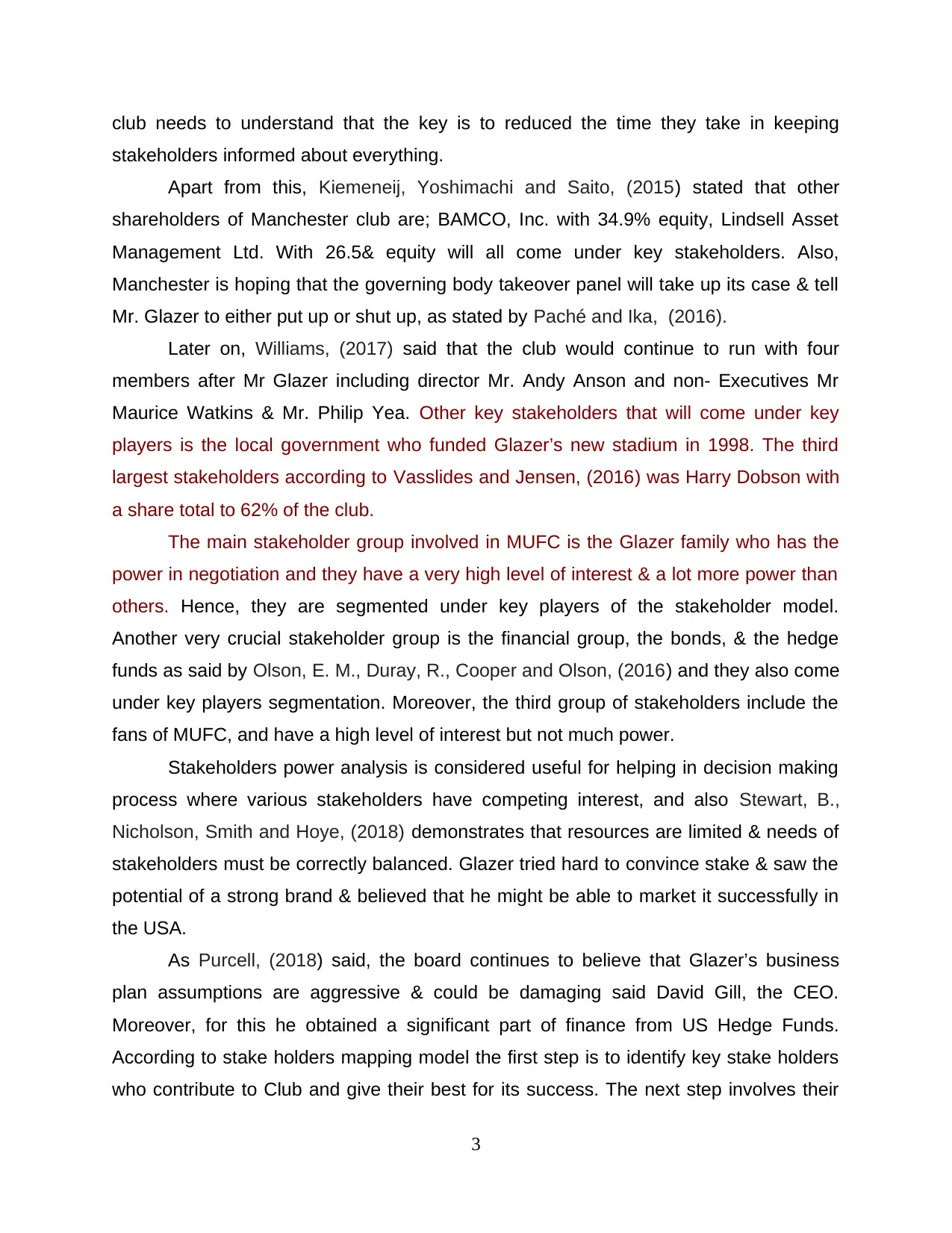
club needs to understand that the key is to reduced the time they take in keeping
stakeholders informed about everything.
Apart from this, Kiemeneij, Yoshimachi and Saito, (2015) stated that other
shareholders of Manchester club are; BAMCO, Inc. with 34.9% equity, Lindsell Asset
Management Ltd. With 26.5& equity will all come under key stakeholders. Also,
Manchester is hoping that the governing body takeover panel will take up its case & tell
Mr. Glazer to either put up or shut up, as stated by Paché and Ika, (2016).
Later on, Williams, (2017) said that the club would continue to run with four
members after Mr Glazer including director Mr. Andy Anson and non- Executives Mr
Maurice Watkins & Mr. Philip Yea. Other key stakeholders that will come under key
players is the local government who funded Glazer’s new stadium in 1998. The third
largest stakeholders according to Vasslides and Jensen, (2016) was Harry Dobson with
a share total to 62% of the club.
The main stakeholder group involved in MUFC is the Glazer family who has the
power in negotiation and they have a very high level of interest & a lot more power than
others. Hence, they are segmented under key players of the stakeholder model.
Another very crucial stakeholder group is the financial group, the bonds, & the hedge
funds as said by Olson, E. M., Duray, R., Cooper and Olson, (2016) and they also come
under key players segmentation. Moreover, the third group of stakeholders include the
fans of MUFC, and have a high level of interest but not much power.
Stakeholders power analysis is considered useful for helping in decision making
process where various stakeholders have competing interest, and also Stewart, B.,
Nicholson, Smith and Hoye, (2018) demonstrates that resources are limited & needs of
stakeholders must be correctly balanced. Glazer tried hard to convince stake & saw the
potential of a strong brand & believed that he might be able to market it successfully in
the USA.
As Purcell, (2018) said, the board continues to believe that Glazer’s business
plan assumptions are aggressive & could be damaging said David Gill, the CEO.
Moreover, for this he obtained a significant part of finance from US Hedge Funds.
According to stake holders mapping model the first step is to identify key stake holders
who contribute to Club and give their best for its success. The next step involves their
3
stakeholders informed about everything.
Apart from this, Kiemeneij, Yoshimachi and Saito, (2015) stated that other
shareholders of Manchester club are; BAMCO, Inc. with 34.9% equity, Lindsell Asset
Management Ltd. With 26.5& equity will all come under key stakeholders. Also,
Manchester is hoping that the governing body takeover panel will take up its case & tell
Mr. Glazer to either put up or shut up, as stated by Paché and Ika, (2016).
Later on, Williams, (2017) said that the club would continue to run with four
members after Mr Glazer including director Mr. Andy Anson and non- Executives Mr
Maurice Watkins & Mr. Philip Yea. Other key stakeholders that will come under key
players is the local government who funded Glazer’s new stadium in 1998. The third
largest stakeholders according to Vasslides and Jensen, (2016) was Harry Dobson with
a share total to 62% of the club.
The main stakeholder group involved in MUFC is the Glazer family who has the
power in negotiation and they have a very high level of interest & a lot more power than
others. Hence, they are segmented under key players of the stakeholder model.
Another very crucial stakeholder group is the financial group, the bonds, & the hedge
funds as said by Olson, E. M., Duray, R., Cooper and Olson, (2016) and they also come
under key players segmentation. Moreover, the third group of stakeholders include the
fans of MUFC, and have a high level of interest but not much power.
Stakeholders power analysis is considered useful for helping in decision making
process where various stakeholders have competing interest, and also Stewart, B.,
Nicholson, Smith and Hoye, (2018) demonstrates that resources are limited & needs of
stakeholders must be correctly balanced. Glazer tried hard to convince stake & saw the
potential of a strong brand & believed that he might be able to market it successfully in
the USA.
As Purcell, (2018) said, the board continues to believe that Glazer’s business
plan assumptions are aggressive & could be damaging said David Gill, the CEO.
Moreover, for this he obtained a significant part of finance from US Hedge Funds.
According to stake holders mapping model the first step is to identify key stake holders
who contribute to Club and give their best for its success. The next step involves their
3
⊘ This is a preview!⊘
Do you want full access?
Subscribe today to unlock all pages.

Trusted by 1+ million students worldwide
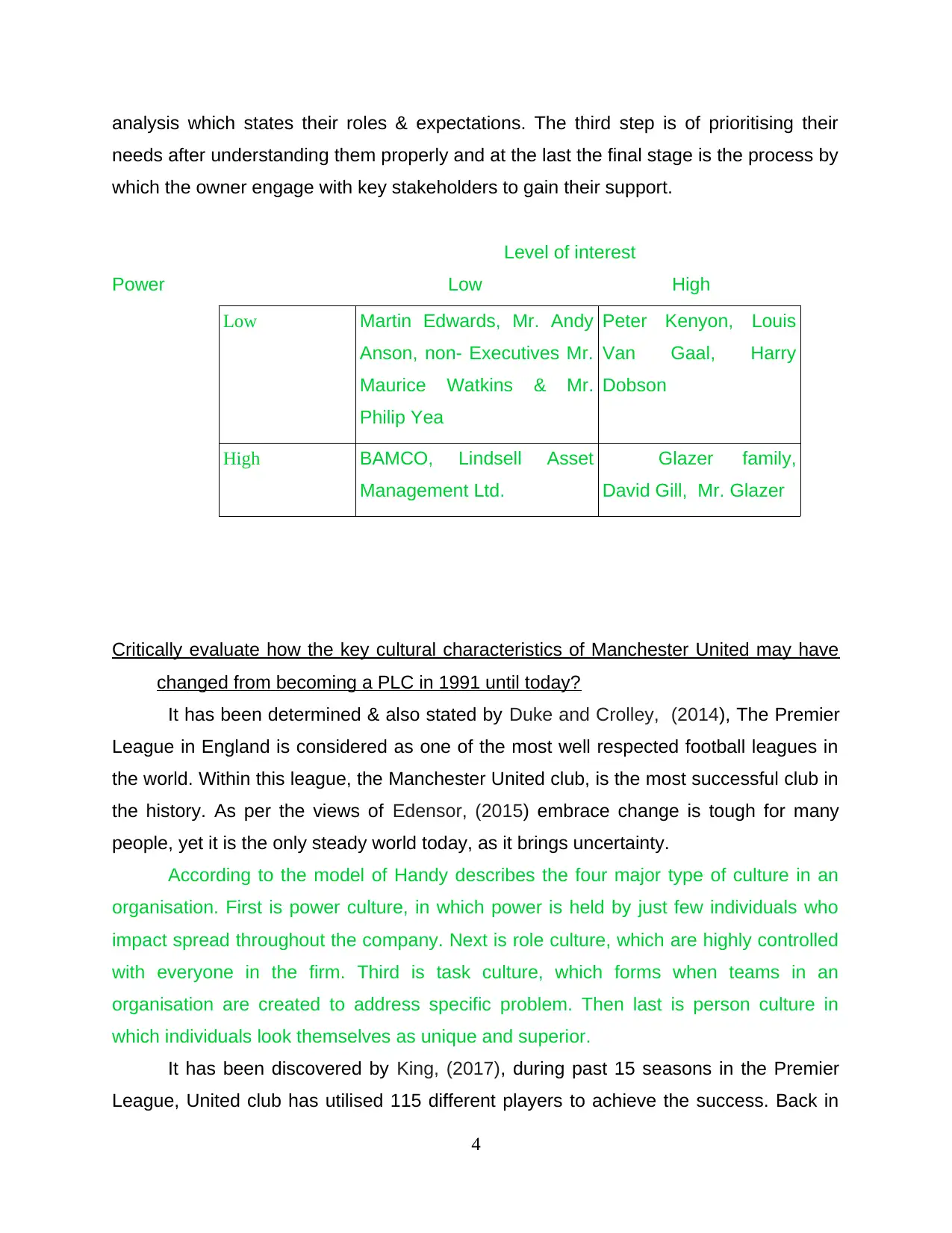
analysis which states their roles & expectations. The third step is of prioritising their
needs after understanding them properly and at the last the final stage is the process by
which the owner engage with key stakeholders to gain their support.
Level of interest
Power Low High
Low Martin Edwards, Mr. Andy
Anson, non- Executives Mr.
Maurice Watkins & Mr.
Philip Yea
Peter Kenyon, Louis
Van Gaal, Harry
Dobson
High BAMCO, Lindsell Asset
Management Ltd.
Glazer family,
David Gill, Mr. Glazer
Critically evaluate how the key cultural characteristics of Manchester United may have
changed from becoming a PLC in 1991 until today?
It has been determined & also stated by Duke and Crolley, (2014), The Premier
League in England is considered as one of the most well respected football leagues in
the world. Within this league, the Manchester United club, is the most successful club in
the history. As per the views of Edensor, (2015) embrace change is tough for many
people, yet it is the only steady world today, as it brings uncertainty.
According to the model of Handy describes the four major type of culture in an
organisation. First is power culture, in which power is held by just few individuals who
impact spread throughout the company. Next is role culture, which are highly controlled
with everyone in the firm. Third is task culture, which forms when teams in an
organisation are created to address specific problem. Then last is person culture in
which individuals look themselves as unique and superior.
It has been discovered by King, (2017), during past 15 seasons in the Premier
League, United club has utilised 115 different players to achieve the success. Back in
4
needs after understanding them properly and at the last the final stage is the process by
which the owner engage with key stakeholders to gain their support.
Level of interest
Power Low High
Low Martin Edwards, Mr. Andy
Anson, non- Executives Mr.
Maurice Watkins & Mr.
Philip Yea
Peter Kenyon, Louis
Van Gaal, Harry
Dobson
High BAMCO, Lindsell Asset
Management Ltd.
Glazer family,
David Gill, Mr. Glazer
Critically evaluate how the key cultural characteristics of Manchester United may have
changed from becoming a PLC in 1991 until today?
It has been determined & also stated by Duke and Crolley, (2014), The Premier
League in England is considered as one of the most well respected football leagues in
the world. Within this league, the Manchester United club, is the most successful club in
the history. As per the views of Edensor, (2015) embrace change is tough for many
people, yet it is the only steady world today, as it brings uncertainty.
According to the model of Handy describes the four major type of culture in an
organisation. First is power culture, in which power is held by just few individuals who
impact spread throughout the company. Next is role culture, which are highly controlled
with everyone in the firm. Third is task culture, which forms when teams in an
organisation are created to address specific problem. Then last is person culture in
which individuals look themselves as unique and superior.
It has been discovered by King, (2017), during past 15 seasons in the Premier
League, United club has utilised 115 different players to achieve the success. Back in
4
Paraphrase This Document
Need a fresh take? Get an instant paraphrase of this document with our AI Paraphraser
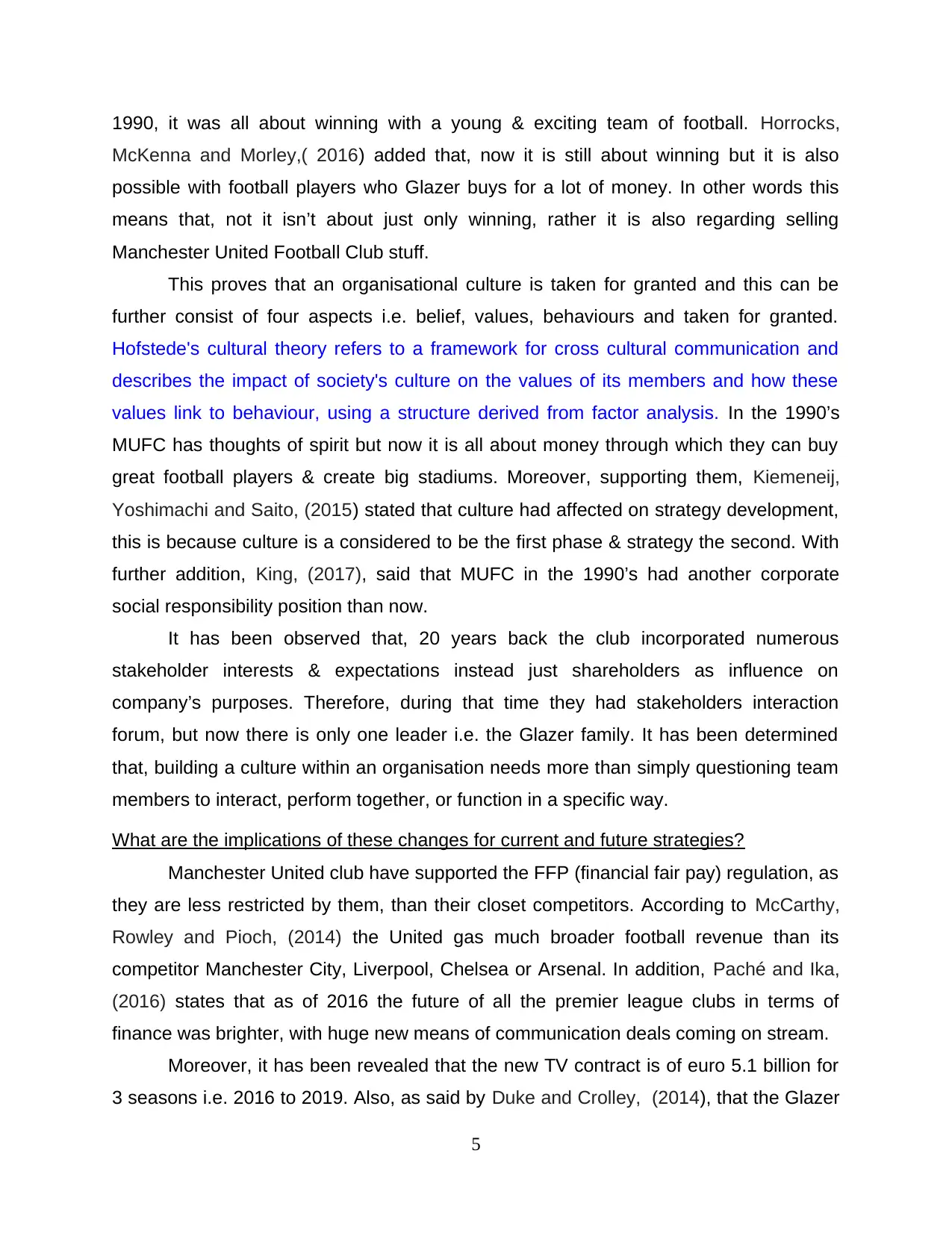
1990, it was all about winning with a young & exciting team of football. Horrocks,
McKenna and Morley,( 2016) added that, now it is still about winning but it is also
possible with football players who Glazer buys for a lot of money. In other words this
means that, not it isn’t about just only winning, rather it is also regarding selling
Manchester United Football Club stuff.
This proves that an organisational culture is taken for granted and this can be
further consist of four aspects i.e. belief, values, behaviours and taken for granted.
Hofstede's cultural theory refers to a framework for cross cultural communication and
describes the impact of society's culture on the values of its members and how these
values link to behaviour, using a structure derived from factor analysis. In the 1990’s
MUFC has thoughts of spirit but now it is all about money through which they can buy
great football players & create big stadiums. Moreover, supporting them, Kiemeneij,
Yoshimachi and Saito, (2015) stated that culture had affected on strategy development,
this is because culture is a considered to be the first phase & strategy the second. With
further addition, King, (2017), said that MUFC in the 1990’s had another corporate
social responsibility position than now.
It has been observed that, 20 years back the club incorporated numerous
stakeholder interests & expectations instead just shareholders as influence on
company’s purposes. Therefore, during that time they had stakeholders interaction
forum, but now there is only one leader i.e. the Glazer family. It has been determined
that, building a culture within an organisation needs more than simply questioning team
members to interact, perform together, or function in a specific way.
What are the implications of these changes for current and future strategies?
Manchester United club have supported the FFP (financial fair pay) regulation, as
they are less restricted by them, than their closet competitors. According to McCarthy,
Rowley and Pioch, (2014) the United gas much broader football revenue than its
competitor Manchester City, Liverpool, Chelsea or Arsenal. In addition, Paché and Ika,
(2016) states that as of 2016 the future of all the premier league clubs in terms of
finance was brighter, with huge new means of communication deals coming on stream.
Moreover, it has been revealed that the new TV contract is of euro 5.1 billion for
3 seasons i.e. 2016 to 2019. Also, as said by Duke and Crolley, (2014), that the Glazer
5
McKenna and Morley,( 2016) added that, now it is still about winning but it is also
possible with football players who Glazer buys for a lot of money. In other words this
means that, not it isn’t about just only winning, rather it is also regarding selling
Manchester United Football Club stuff.
This proves that an organisational culture is taken for granted and this can be
further consist of four aspects i.e. belief, values, behaviours and taken for granted.
Hofstede's cultural theory refers to a framework for cross cultural communication and
describes the impact of society's culture on the values of its members and how these
values link to behaviour, using a structure derived from factor analysis. In the 1990’s
MUFC has thoughts of spirit but now it is all about money through which they can buy
great football players & create big stadiums. Moreover, supporting them, Kiemeneij,
Yoshimachi and Saito, (2015) stated that culture had affected on strategy development,
this is because culture is a considered to be the first phase & strategy the second. With
further addition, King, (2017), said that MUFC in the 1990’s had another corporate
social responsibility position than now.
It has been observed that, 20 years back the club incorporated numerous
stakeholder interests & expectations instead just shareholders as influence on
company’s purposes. Therefore, during that time they had stakeholders interaction
forum, but now there is only one leader i.e. the Glazer family. It has been determined
that, building a culture within an organisation needs more than simply questioning team
members to interact, perform together, or function in a specific way.
What are the implications of these changes for current and future strategies?
Manchester United club have supported the FFP (financial fair pay) regulation, as
they are less restricted by them, than their closet competitors. According to McCarthy,
Rowley and Pioch, (2014) the United gas much broader football revenue than its
competitor Manchester City, Liverpool, Chelsea or Arsenal. In addition, Paché and Ika,
(2016) states that as of 2016 the future of all the premier league clubs in terms of
finance was brighter, with huge new means of communication deals coming on stream.
Moreover, it has been revealed that the new TV contract is of euro 5.1 billion for
3 seasons i.e. 2016 to 2019. Also, as said by Duke and Crolley, (2014), that the Glazer
5
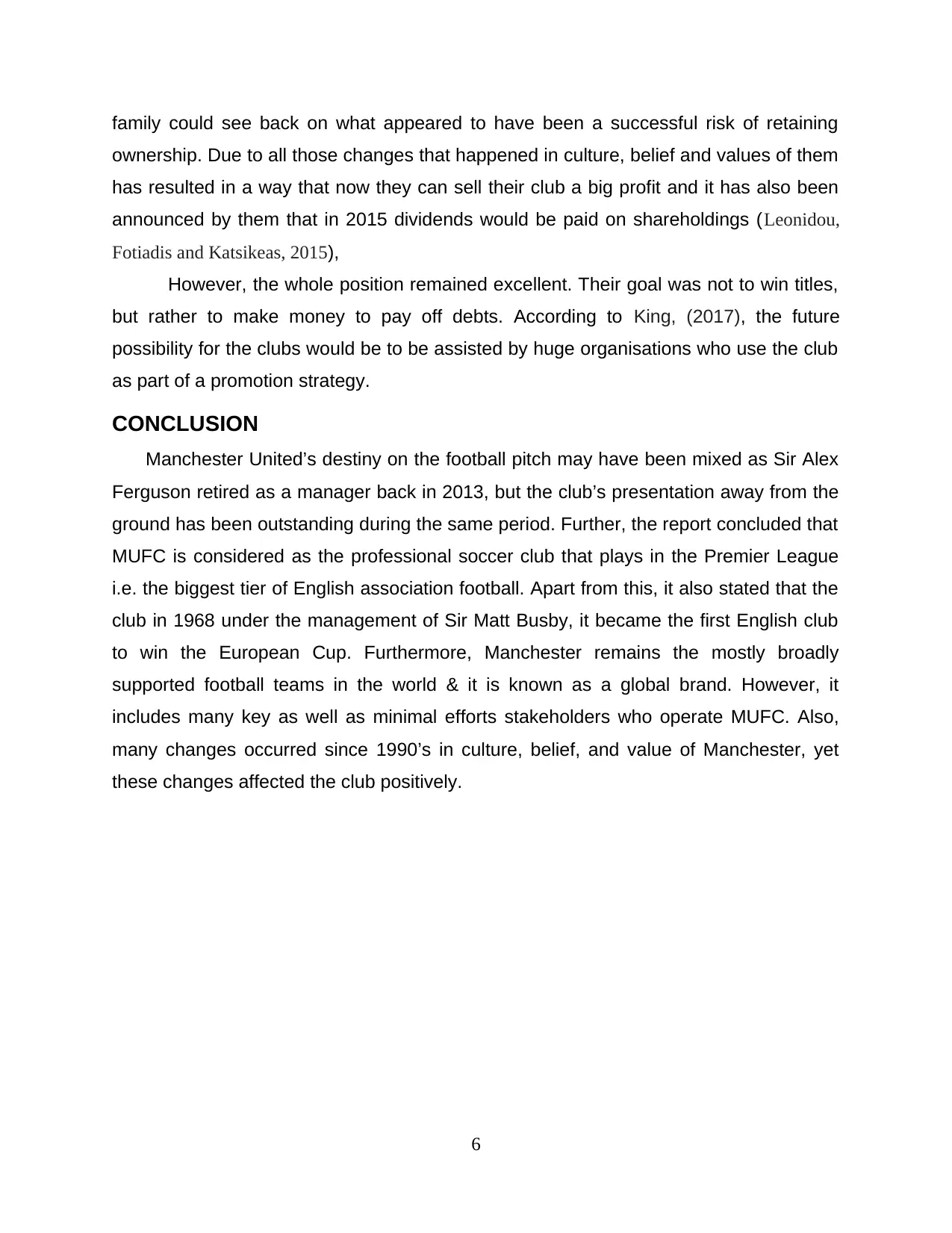
family could see back on what appeared to have been a successful risk of retaining
ownership. Due to all those changes that happened in culture, belief and values of them
has resulted in a way that now they can sell their club a big profit and it has also been
announced by them that in 2015 dividends would be paid on shareholdings (Leonidou,
Fotiadis and Katsikeas, 2015),
However, the whole position remained excellent. Their goal was not to win titles,
but rather to make money to pay off debts. According to King, (2017), the future
possibility for the clubs would be to be assisted by huge organisations who use the club
as part of a promotion strategy.
CONCLUSION
Manchester United’s destiny on the football pitch may have been mixed as Sir Alex
Ferguson retired as a manager back in 2013, but the club’s presentation away from the
ground has been outstanding during the same period. Further, the report concluded that
MUFC is considered as the professional soccer club that plays in the Premier League
i.e. the biggest tier of English association football. Apart from this, it also stated that the
club in 1968 under the management of Sir Matt Busby, it became the first English club
to win the European Cup. Furthermore, Manchester remains the mostly broadly
supported football teams in the world & it is known as a global brand. However, it
includes many key as well as minimal efforts stakeholders who operate MUFC. Also,
many changes occurred since 1990’s in culture, belief, and value of Manchester, yet
these changes affected the club positively.
6
ownership. Due to all those changes that happened in culture, belief and values of them
has resulted in a way that now they can sell their club a big profit and it has also been
announced by them that in 2015 dividends would be paid on shareholdings (Leonidou,
Fotiadis and Katsikeas, 2015),
However, the whole position remained excellent. Their goal was not to win titles,
but rather to make money to pay off debts. According to King, (2017), the future
possibility for the clubs would be to be assisted by huge organisations who use the club
as part of a promotion strategy.
CONCLUSION
Manchester United’s destiny on the football pitch may have been mixed as Sir Alex
Ferguson retired as a manager back in 2013, but the club’s presentation away from the
ground has been outstanding during the same period. Further, the report concluded that
MUFC is considered as the professional soccer club that plays in the Premier League
i.e. the biggest tier of English association football. Apart from this, it also stated that the
club in 1968 under the management of Sir Matt Busby, it became the first English club
to win the European Cup. Furthermore, Manchester remains the mostly broadly
supported football teams in the world & it is known as a global brand. However, it
includes many key as well as minimal efforts stakeholders who operate MUFC. Also,
many changes occurred since 1990’s in culture, belief, and value of Manchester, yet
these changes affected the club positively.
6
⊘ This is a preview!⊘
Do you want full access?
Subscribe today to unlock all pages.

Trusted by 1+ million students worldwide
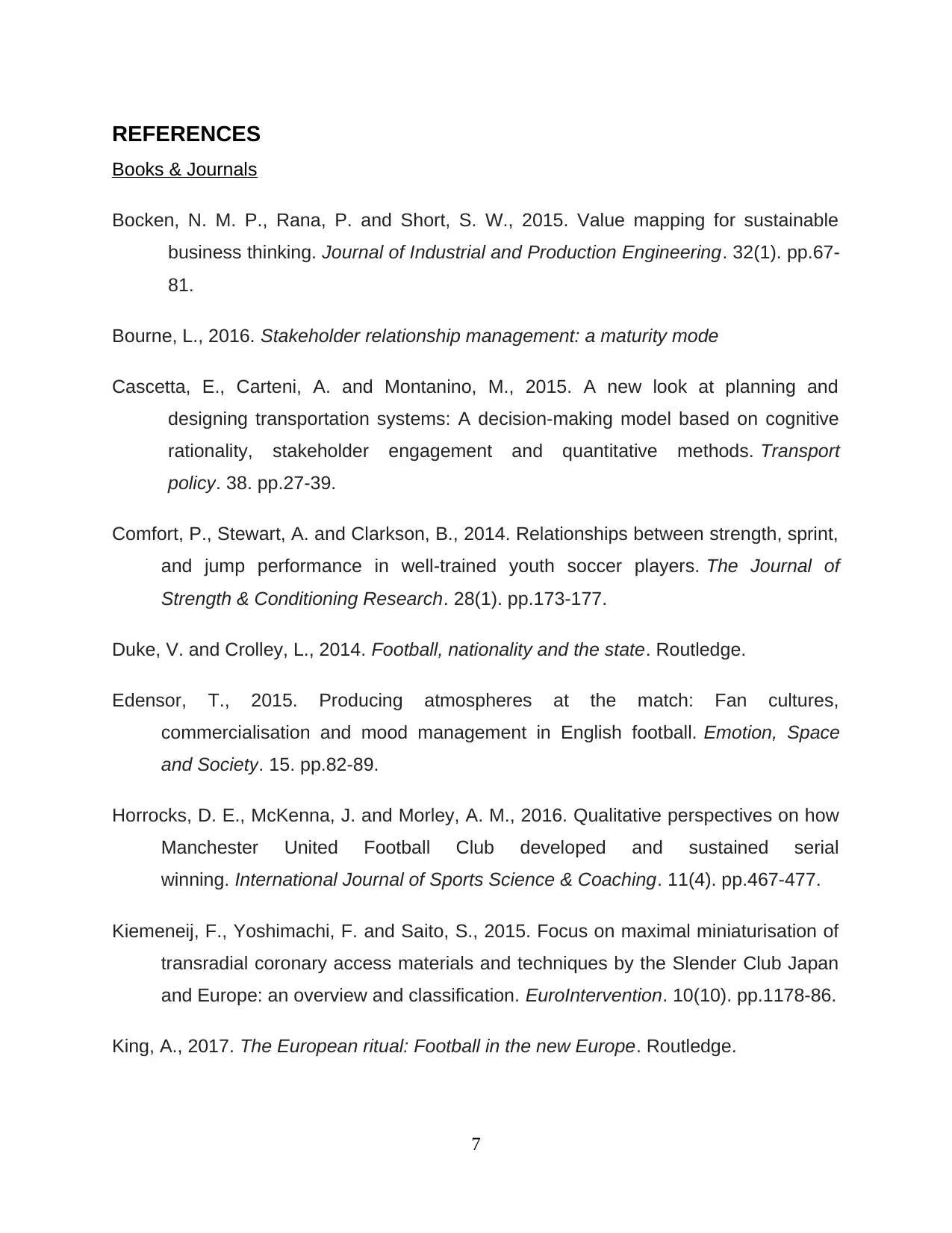
REFERENCES
Books & Journals
Bocken, N. M. P., Rana, P. and Short, S. W., 2015. Value mapping for sustainable
business thinking. Journal of Industrial and Production Engineering. 32(1). pp.67-
81.
Bourne, L., 2016. Stakeholder relationship management: a maturity mode
Cascetta, E., Carteni, A. and Montanino, M., 2015. A new look at planning and
designing transportation systems: A decision-making model based on cognitive
rationality, stakeholder engagement and quantitative methods. Transport
policy. 38. pp.27-39.
Comfort, P., Stewart, A. and Clarkson, B., 2014. Relationships between strength, sprint,
and jump performance in well-trained youth soccer players. The Journal of
Strength & Conditioning Research. 28(1). pp.173-177.
Duke, V. and Crolley, L., 2014. Football, nationality and the state. Routledge.
Edensor, T., 2015. Producing atmospheres at the match: Fan cultures,
commercialisation and mood management in English football. Emotion, Space
and Society. 15. pp.82-89.
Horrocks, D. E., McKenna, J. and Morley, A. M., 2016. Qualitative perspectives on how
Manchester United Football Club developed and sustained serial
winning. International Journal of Sports Science & Coaching. 11(4). pp.467-477.
Kiemeneij, F., Yoshimachi, F. and Saito, S., 2015. Focus on maximal miniaturisation of
transradial coronary access materials and techniques by the Slender Club Japan
and Europe: an overview and classification. EuroIntervention. 10(10). pp.1178-86.
King, A., 2017. The European ritual: Football in the new Europe. Routledge.
7
Books & Journals
Bocken, N. M. P., Rana, P. and Short, S. W., 2015. Value mapping for sustainable
business thinking. Journal of Industrial and Production Engineering. 32(1). pp.67-
81.
Bourne, L., 2016. Stakeholder relationship management: a maturity mode
Cascetta, E., Carteni, A. and Montanino, M., 2015. A new look at planning and
designing transportation systems: A decision-making model based on cognitive
rationality, stakeholder engagement and quantitative methods. Transport
policy. 38. pp.27-39.
Comfort, P., Stewart, A. and Clarkson, B., 2014. Relationships between strength, sprint,
and jump performance in well-trained youth soccer players. The Journal of
Strength & Conditioning Research. 28(1). pp.173-177.
Duke, V. and Crolley, L., 2014. Football, nationality and the state. Routledge.
Edensor, T., 2015. Producing atmospheres at the match: Fan cultures,
commercialisation and mood management in English football. Emotion, Space
and Society. 15. pp.82-89.
Horrocks, D. E., McKenna, J. and Morley, A. M., 2016. Qualitative perspectives on how
Manchester United Football Club developed and sustained serial
winning. International Journal of Sports Science & Coaching. 11(4). pp.467-477.
Kiemeneij, F., Yoshimachi, F. and Saito, S., 2015. Focus on maximal miniaturisation of
transradial coronary access materials and techniques by the Slender Club Japan
and Europe: an overview and classification. EuroIntervention. 10(10). pp.1178-86.
King, A., 2017. The European ritual: Football in the new Europe. Routledge.
7
Paraphrase This Document
Need a fresh take? Get an instant paraphrase of this document with our AI Paraphraser
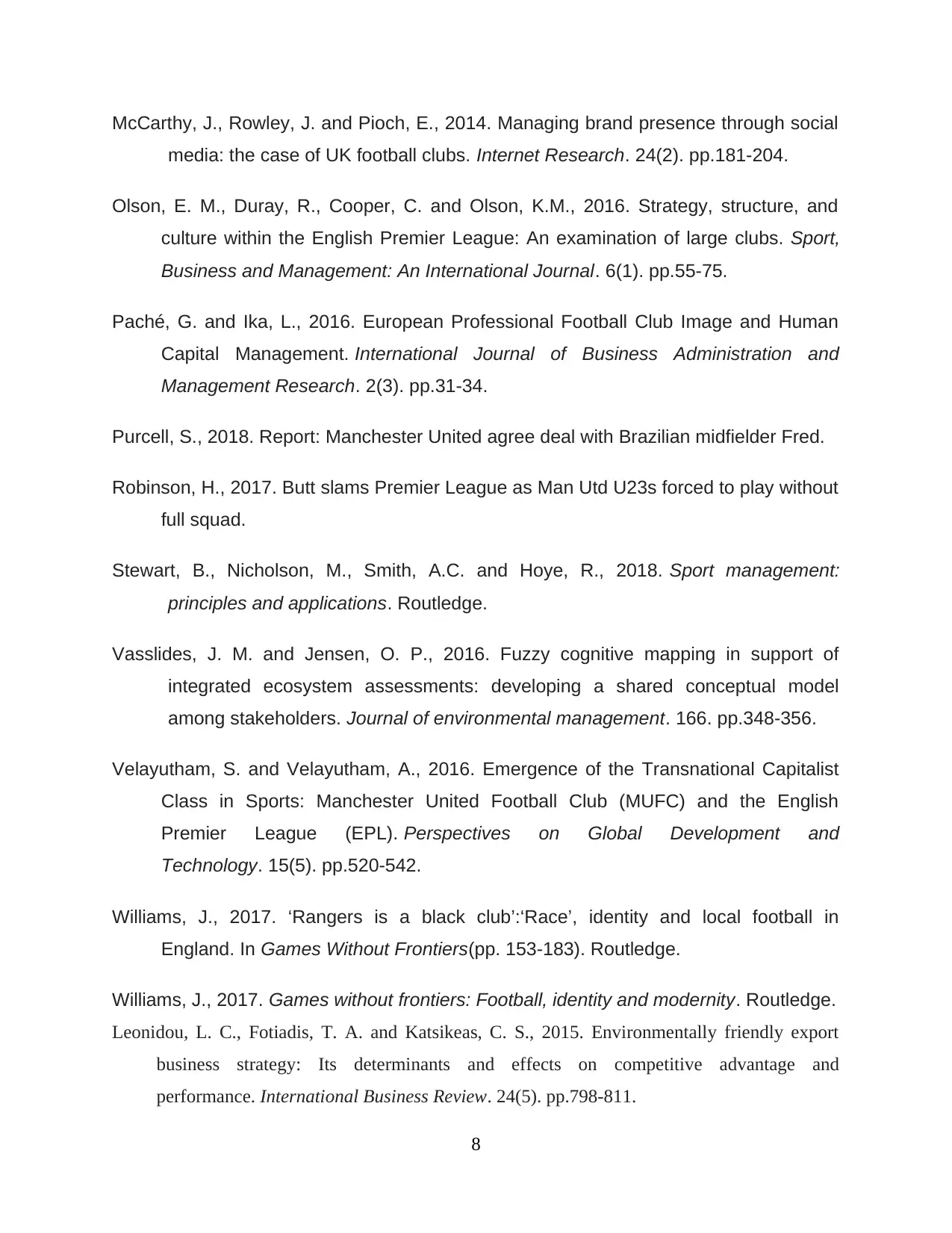
McCarthy, J., Rowley, J. and Pioch, E., 2014. Managing brand presence through social
media: the case of UK football clubs. Internet Research. 24(2). pp.181-204.
Olson, E. M., Duray, R., Cooper, C. and Olson, K.M., 2016. Strategy, structure, and
culture within the English Premier League: An examination of large clubs. Sport,
Business and Management: An International Journal. 6(1). pp.55-75.
Paché, G. and Ika, L., 2016. European Professional Football Club Image and Human
Capital Management. International Journal of Business Administration and
Management Research. 2(3). pp.31-34.
Purcell, S., 2018. Report: Manchester United agree deal with Brazilian midfielder Fred.
Robinson, H., 2017. Butt slams Premier League as Man Utd U23s forced to play without
full squad.
Stewart, B., Nicholson, M., Smith, A.C. and Hoye, R., 2018. Sport management:
principles and applications. Routledge.
Vasslides, J. M. and Jensen, O. P., 2016. Fuzzy cognitive mapping in support of
integrated ecosystem assessments: developing a shared conceptual model
among stakeholders. Journal of environmental management. 166. pp.348-356.
Velayutham, S. and Velayutham, A., 2016. Emergence of the Transnational Capitalist
Class in Sports: Manchester United Football Club (MUFC) and the English
Premier League (EPL). Perspectives on Global Development and
Technology. 15(5). pp.520-542.
Williams, J., 2017. ‘Rangers is a black club’:‘Race’, identity and local football in
England. In Games Without Frontiers(pp. 153-183). Routledge.
Williams, J., 2017. Games without frontiers: Football, identity and modernity. Routledge.
Leonidou, L. C., Fotiadis, T. A. and Katsikeas, C. S., 2015. Environmentally friendly export
business strategy: Its determinants and effects on competitive advantage and
performance. International Business Review. 24(5). pp.798-811.
8
media: the case of UK football clubs. Internet Research. 24(2). pp.181-204.
Olson, E. M., Duray, R., Cooper, C. and Olson, K.M., 2016. Strategy, structure, and
culture within the English Premier League: An examination of large clubs. Sport,
Business and Management: An International Journal. 6(1). pp.55-75.
Paché, G. and Ika, L., 2016. European Professional Football Club Image and Human
Capital Management. International Journal of Business Administration and
Management Research. 2(3). pp.31-34.
Purcell, S., 2018. Report: Manchester United agree deal with Brazilian midfielder Fred.
Robinson, H., 2017. Butt slams Premier League as Man Utd U23s forced to play without
full squad.
Stewart, B., Nicholson, M., Smith, A.C. and Hoye, R., 2018. Sport management:
principles and applications. Routledge.
Vasslides, J. M. and Jensen, O. P., 2016. Fuzzy cognitive mapping in support of
integrated ecosystem assessments: developing a shared conceptual model
among stakeholders. Journal of environmental management. 166. pp.348-356.
Velayutham, S. and Velayutham, A., 2016. Emergence of the Transnational Capitalist
Class in Sports: Manchester United Football Club (MUFC) and the English
Premier League (EPL). Perspectives on Global Development and
Technology. 15(5). pp.520-542.
Williams, J., 2017. ‘Rangers is a black club’:‘Race’, identity and local football in
England. In Games Without Frontiers(pp. 153-183). Routledge.
Williams, J., 2017. Games without frontiers: Football, identity and modernity. Routledge.
Leonidou, L. C., Fotiadis, T. A. and Katsikeas, C. S., 2015. Environmentally friendly export
business strategy: Its determinants and effects on competitive advantage and
performance. International Business Review. 24(5). pp.798-811.
8
1 out of 11
Your All-in-One AI-Powered Toolkit for Academic Success.
+13062052269
info@desklib.com
Available 24*7 on WhatsApp / Email
![[object Object]](/_next/static/media/star-bottom.7253800d.svg)
Unlock your academic potential
Copyright © 2020–2025 A2Z Services. All Rights Reserved. Developed and managed by ZUCOL.


